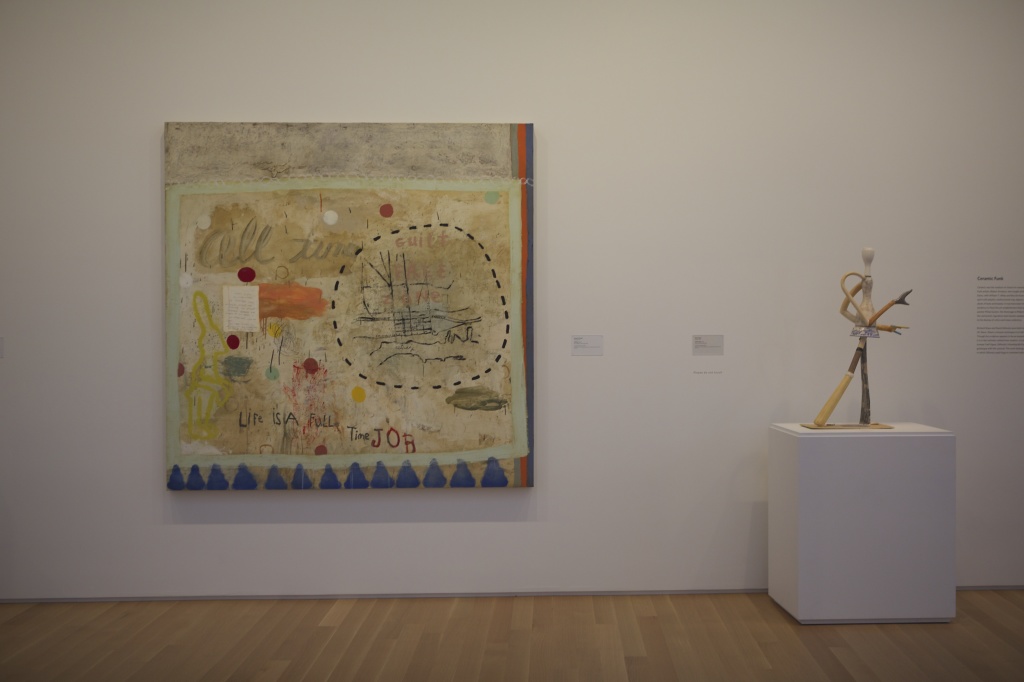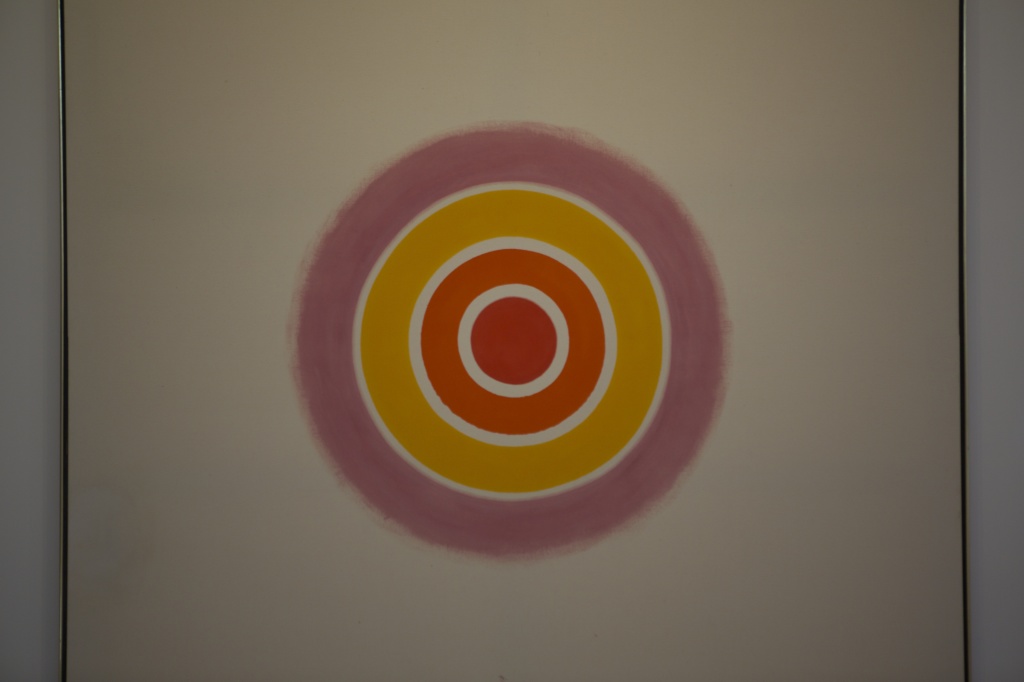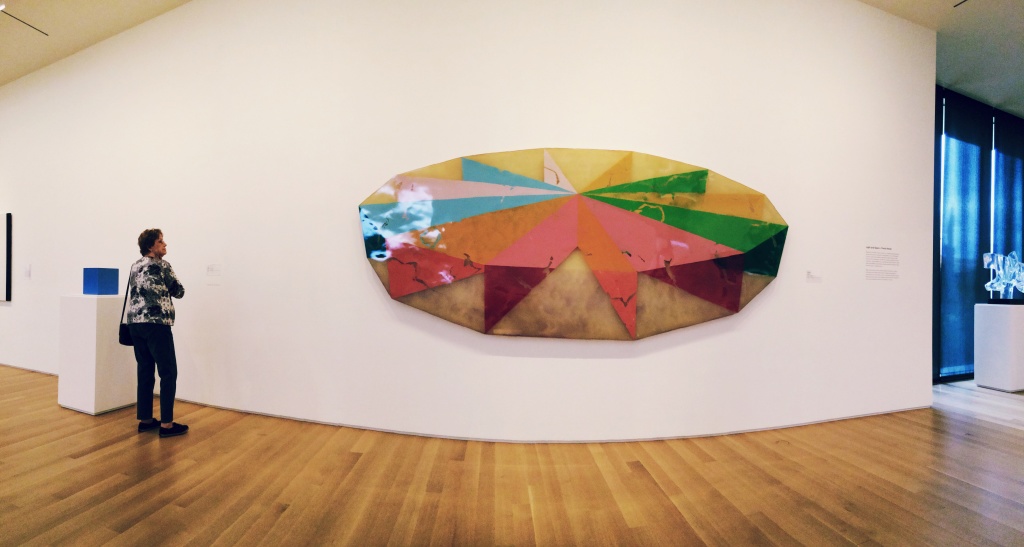At the Stanford Arts Review, we find the Andersons’ generous gift to Stanford a cause for both public and intimate celebration. We encourage you to visit the collection, force your expectations of art out the door and open yourself to discomfort. For what is modern and contemporary art, after all? Scribbles on a canvas, clean lines, exultations of color that arise in all their material glory from the human mind.
We now bring you a weekly series where our writers confront each painting and sculpture in the Anderson Collection, from 001 to 121. This week: Squeak Carnwath’s Full Time, Kenneth Noland’s Rose, and Ronald Davis’ Spoke.
010. Kelsey Dayton on Squeak Carnwath’s Full Time

I was a babysitter in high school, churning out English papers while making sure the three kids next door didn’t burn their house down or cook anything with shellfish (the youngest was allergic to shellfish. This isn’t exactly something six-year-olds could easily get their hands on, but alas, I was vigilant.). Doing work and watching them always sort of stressed me out. They were loud, watched “Courage the Cowardly Dog”—which is a very stressful show and should be rated at least PG-13— and wanted to play hide-and-seek while I was trying to be profound about Robert Frost.
One day the oldest sister asked me how I was doing and I said, “I’ll be a lot happier when I finish this commentary.” She considered me a moment and then said, “You look pretty happy to me.”
That memory is what came to mind on Monday when I went and placed myself directly in front of Full Time by Squeak Carnwath. The color scheme is playground recess on canvas: at once autumnal and reminiscent of coloring books. All the geometric patterns and scribbles suggest a childish naiveté, an artist who is just now learning to use oil paints.
And yet there is a sustained, knowing wisdom running beneath this surface-level pose of shrugging innocence. Carnwath claims, in jest, to have stumbled across some fundamental truth about life in the modern world without really knowing what she’s found. “Life is a full-time job.” She wants to present us with this truth in a confluence of images—this abstraction of the hectic, joyous, mortal festival—laugh airily, and dash away again. But we know she knows, and thus there’s a difference between Carnwath and a child. The child, uncorrupted by the world’s jading influence, effortlessly speaks wisdom and reminds us that, even though we get wrapped up in routine chaos, we are happy. Carnwath, on the other hand, is very much corrupted, and has painstakingly identified that human tendency and decided to cast it into sharp relief. Maybe if she dresses it up so innocently we’ll take it seriously. We’ll remember to enjoy the ferris wheel, to love the job.
011. Stephanie Wang on Kenneth Noland’s Rose

A rose demands to be the center of attention. We give it to each other as a symbol of our attention. It represents passion, an end goal, and a reward for achievement. It’s love, beauty, and attraction. At times we put on a feverish pursuit or develop a dangerous obsession with what it represents, but it can also return softness and warmth, leaving one glowing in satisfaction.
Kenneth Noland’s Rose emits a warm and inviting aura from a distance, slowly drawing you in until you are standing in front of the enormous stretched canvas, fixated on the pulsating glow of it’s molten orange core. Progressing from deep vermillion to a soft feathery pink, the piece resembles a target, or levels where each rung represents a state of the mind. Starting in the depths of deep heated orange, I recall my pursuits, my passions, objects that command my desire, fleeting moments of feeling like I am on fire. My eyes progress to the next rung where a warm yellow-gold recalls moments of pride, achievement, and states of sheer contentment. I return to calmness as my eyes follow the soft pink edges of Rose, and am brought back to the placid neutrality of untouched canvas.
Noland explores patterns of human instinct through his provocative use of colors and primitive shapes. He encourages us to pluck the petals off of Rose to unveil our secret heart. A glimpse at the raw core that keeps us alive.
012. Austin Seidel on Ronald Davis’ Spoke

Ronald Davis’s colorful coagulation of plastic, resin, and fiberglass juts from the white expanse of the Anderson Collection and demands to be devoured. The almost-pastel, almost-neon bars that radiate from the center shift as I walk back and forth, sometimes shaping into a lopsided candy, sometimes a smushed circus tent.
Ronald Davis created Spoke during a period when artists in California were experimenting with alternative painting mediums, such as polyester resin. Using industrial techniques to create Spoke, Davis’s piece reflects the growing car culture in 1960s Los Angeles. By breaking down this normally mechanical image and reshaping it into something colorful and almost whimsical, Davis seems to comment on the blatant consumerism—the devouring—of car, and possibly American, culture.
The almost-pastel, almost-neon bars of Spoke feel very childlike—and this contrasts with my normal perception of wheels as metallic, distant, constantly moving. There’s ultimately something simultaneously cold yet warm about this wheel, something contradictory. And as I continue to walk back and forth from its radiating center, I can’t help but think that the wheel surely can and should be reinvented.
